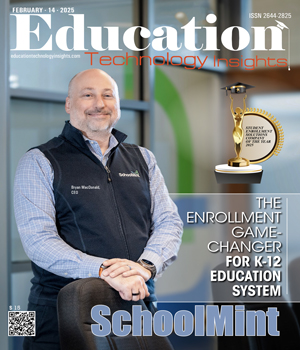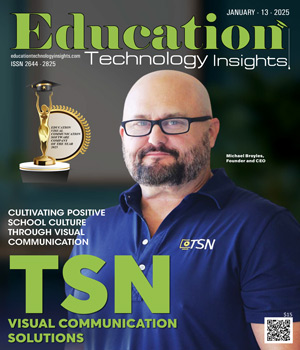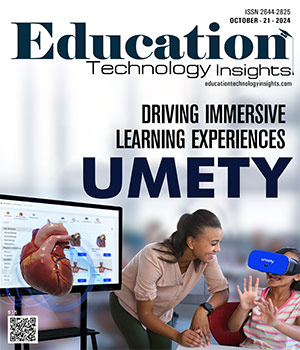THANK YOU FOR SUBSCRIBING
Be first to read the latest tech news, Industry Leader's Insights, and CIO interviews of medium and large enterprises exclusively from Education Technology Insights
Key AI Implementation Considerations for Educational Technology in 2025
Diane Gavin, Executive Director–Center for Academic Innovation, Texas A&M University-San Antonio
 Diane Gavin, Executive Director–Center for Academic Innovation, Texas A&M University-San Antonio
Diane Gavin, Executive Director–Center for Academic Innovation, Texas A&M University-San AntonioThe following statement is no surprise to anyone in educational technology: The AI environment moves incredibly quickly for educational technologists. However, if we can try to isolate the AI environment, five key areas seem stable despite the AI swirl:
• Ethical AI Use and Student Data Privacy: The regulatory landscape for AI in education has tightened significantly, with stricter guidelines on student data protection, consent requirements and transparency in algorithmic decision-making. Education technologists need robust data governance frameworks that follow updated local, state and federal educational privacy laws while enabling AI functionality.
• Personalized Learning Pathways: AI-driven adaptive learning systems have matured beyond simple content recommendations to create individualized student journeys. The most effective implementations combine student performance data, student learning preferences and class or subject contextual factors to dynamically adjust course difficulty, pacing and content formats in real-time.
• AI as Educator Augmentation Rather Than Replacement: Successful AI integration in educational technology now focuses on enhancing teacher capabilities rather than automating or replacing them. The most effective educational technology models position AI as handling routine tasks like grading, content creation, or administrative work while empowering teachers to focus on relationship-building, complex instruction and developing higher-order thinking skills.
• Accessible AI Design for Different Learning Styles: Universal Design for Learning principles are now essential in selecting or using AI educational tools. AI must account for students’ neurodiversity, language differences, cultural contexts and varying levels of technological access to avoid reinforcing existing educational imbalances.
• Continuous Evaluation Frameworks: Beyond implementation, educational technology professionals need systematic approaches to measure AI's impact on learning outcomes. The framework includes setting up clear metrics for success, supporting regular assessment cycles and creating mechanisms to find and address the likelihood of unfairness that may appear when using AI systems.
“AI continuous evaluation frameworks shift assessment from periodic activity to an integrated process, feeding directly into student and tech improvement while supporting rigorous documentation of both positive and negative impact”
The last key point, Continuous Evaluation Frameworks, is the most recent and essential step forward in AI-assisted educational technology. Continuous evaluation frameworks are dynamic models that focus on formative assessment to provide rapid, ongoing evaluation rather than fixed academic metrics. The ability to use AI to generate multidimensional continuous evaluation based on student learning seems to be the next area where educational technologists should focus their attention.
The rise of AI tools in educational technology offers multidimensional assessment approaches. Evaluation now incorporates multiple dimensions of student learning and programmatic outcomes, such as outcome measurements that track subject mastery using adaptive assessments that adjust to student progress. Student engagement metrics that measure not just time spent on task but also the quality of student interactions with AI systems can help educators select skill-building activities that are course- and grade-level appropriate.
AI system add-ons in LMS systems offer educational technologists an opportunity to examine indicators that show whether specific tools or environments effectively serve all student populations. In educational spaces where a need exists to monitor student mental health or social development, well-being factors can be checked for the possibility of negative influences on these.
Stakeholder feedback loops are a critical part of the continuous evaluation framework. Stakeholder feedback loops provide contextual performance analysis by setting up cross-institutional and privacy-protected data sharing, possible control group comparisons and the ability for longitudinal tracking to explore student impact beyond immediate academic gains.
The most advanced frameworks now include various real-time monitoring systems to provide continuous, advanced evaluation of student progress. Dashboard systems flag potential issues before they become problematic, such as declining engagement patterns, unusual performance shifts, or course combinations that result in students’ poor performance. Algorithmic auditing tools that continuously scan for unintentional or hidden bias in assessments are available. And sentiment analysis of student-AI interactions can show students’ frustration or confusion points that educators can use to respond to student pain points and generate specific clarifying activities or lessons that encourage learning.
Practical evaluation now includes structured input from all parties, from student feedback mechanisms built directly into AI interfaces to administrator review cycles that assess institutional integration. Teacher observation protocols to review dashboard systems and document the impact on classroom performance become central to provide necessary formative assessment throughout a course.
AI continuous evaluation frameworks may close the loop quickly when we can report issues that appear from pedagogical or curricular changes, or have version control systems that track faculty adjustments to AI models for classroom activities.
By setting up AI impact assessment requirements before implementing significant changes, educational technologists may offer greater transparency in reporting to all stakeholders about student performance.AI assisted continuous evaluation frameworks provides the ability to move from evaluation as a periodic activity to an integrated, continuous process that directly feeds back into student and technology improvement while supporting rigorous documentation of positive and negative impact.
Read Also
Our AI Crisis isn't Technical. It's Human.
4 Keys to Managing Change
Active Engagement is the Foundation of Effective Leadership
Empowering Leadership through Innovation in Higher Education
Redefining Readiness: A Path Toward a Technology-Agnostic Future
The New Era of Education

I agree We use cookies on this website to enhance your user experience. By clicking any link on this page you are giving your consent for us to set cookies. More info















-(2)-1.jpg)







